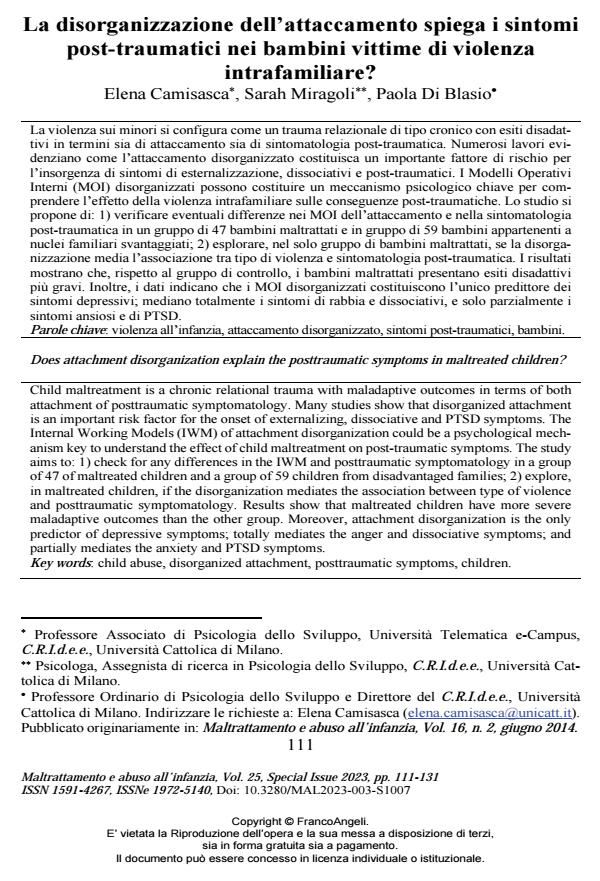La disorganizzazione dell’attaccamento spiega i sintomi post-traumatici nei bambini vittime di violenza intrafamiliare?
Titolo Rivista MALTRATTAMENTO E ABUSO ALL’INFANZIA
Autori/Curatori Elena Camisasca, Sarah Miragoli, Paola Di Blasio
Anno di pubblicazione 2024 Fascicolo 2023/3 Suppl.
Lingua Italiano Numero pagine 21 P. 111-131 Dimensione file 246 KB
DOI 10.3280/MAL2023-003-S1007
Il DOI è il codice a barre della proprietà intellettuale: per saperne di più
clicca qui
Qui sotto puoi vedere in anteprima la prima pagina di questo articolo.
Se questo articolo ti interessa, lo puoi acquistare (e scaricare in formato pdf) seguendo le facili indicazioni per acquistare il download credit. Acquista Download Credits per scaricare questo Articolo in formato PDF

FrancoAngeli è membro della Publishers International Linking Association, Inc (PILA)associazione indipendente e non profit per facilitare (attraverso i servizi tecnologici implementati da CrossRef.org) l’accesso degli studiosi ai contenuti digitali nelle pubblicazioni professionali e scientifiche
La violenza sui minori si configura come un trauma relazionale di tipo cronico con esiti disadattivi in termini sia di attaccamento sia di sintomatologia post-traumatica. Numerosi lavori evidenziano come l’attaccamento disorganizzato costituisca un importante fattore di rischio per l’insorgenza di sintomi di esternalizzazione, dissociativi e post-traumatici. I Modelli Operativi Interni (MOI) disorganizzati possono costituire un meccanismo psicologico chiave per comprendere l’effetto della violenza intrafamiliare sulle conseguenze post-traumatiche. Lo studio si propone di: 1) verificare eventuali differenze nei MOI dell’attaccamento e nella sintomatologia post-traumatica in un gruppo di 47 bambini maltrattati e in gruppo di 59 bambini appartenenti a nuclei familiari svantaggiati; 2) esplorare, nel solo gruppo di bambini maltrattati, se la disorganizzazione media l’associazione tra tipo di violenza e sintomatologia post-traumatica. I risultati mostrano che, rispetto al gruppo di controllo, i bambini maltrattati presentano esiti disadattivi più gravi. Inoltre, i dati indicano che i MOI disorganizzati costituiscono l’unico predittore dei sintomi depressivi; mediano totalmente i sintomi di rabbia e dissociativi, e solo parzialmente i sintomi ansiosi e di PTSD.
Parole chiave:violenza all’infanzia, attaccamento disorganizzato, sintomi post-traumatici, bambini.
Elena Camisasca, Sarah Miragoli, Paola Di Blasio, La disorganizzazione dell’attaccamento spiega i sintomi post-traumatici nei bambini vittime di violenza intrafamiliare? in "MALTRATTAMENTO E ABUSO ALL’INFANZIA" 3 Suppl./2023, pp 111-131, DOI: 10.3280/MAL2023-003-S1007